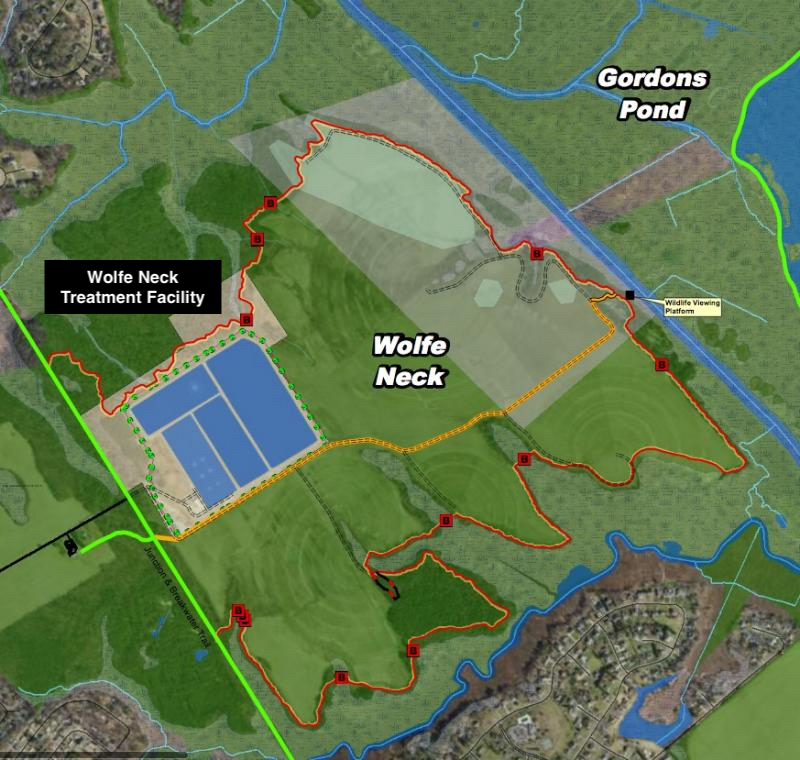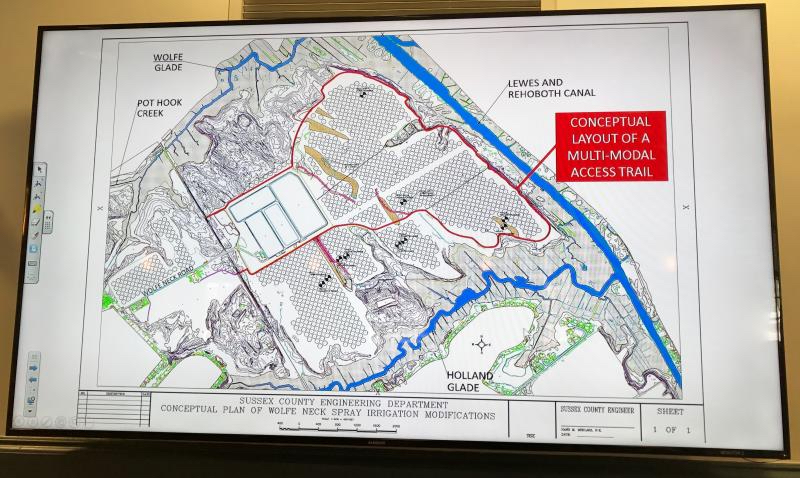DNREC issues statement on Wolfe Neck artifacts
The Division of Parks and Recreation’s proposed bike/pedestrian trail at Wolfe Neck in Cape Henlopen State Park is in limbo.
The site is the current location of the Sussex County Wolfe Neck Regional Wastewater Treatment Facility. The county had plans to convert the nearly 400-acre site to forest and provide access to the state park.
Agreements had been signed and grants applied for, the trail was designed and Sussex County had spent funds in 2022 to design a switch from spray irrigation to fixed-head pivot ground irrigation. The project was full steam ahead and expected to be completed in two to three years.
However, in June 2023, the joint project between Sussex County and the Department of Natural Resources and Environmental Control’s Division of Parks and Recreation hit a snag when significant cultural resources were found during a Phase 1 archaeological study on the proposed trail alignment, which now requires a Phase II study.
Cultural resources are any prehistoric or historic remains or indicators of past human activities, including artifacts, sites, structures, foundations or other objects of importance to a culture or community. According to historical documents and books, Native Americans came to use the area as their summer hunting and fishing grounds.
State officials will not disclose the types of artifacts discovered at the site but did say no human remains have been found.
Plan bogged down
Now, the plan is mired in state and federal bureaucracy relating to the discovery of indigenous and post-contact historic period archaeological sites, which can’t be disturbed.
“These sites are of various sizes and date ranges, and are similar to other sites found in this part of Delaware. The Wolfe Neck Site is recognized as significant to Delaware history and has been listed in the National Register of Historic Places since 1978,” said a Delaware Department of Natural Resources and Environmental Control statement issued recently to the Cape Gazette.
Also, according to the statement, “To protect and preserve any artifacts, state and federal law allow restriction of specific data concerning the location and nature of archaeological sites. The Delaware Department of State Division of Historical and Cultural Affairs and DNREC will not provide such data on the archaeological resources at Wolfe Neck but will provide information on the status of planned projects as updates are available.”
Even after a Cape Gazette Freedom of Information Act request, the state would not release details about the precise type of artifacts found at the site.
Effect on treatment plant
The discovery of the artifacts has also forced Sussex County to take a different approach to its master plan for the Wolfe Neck Regional Wastewater Treatment Facility at the site.
In early 2017, Sussex County announced it had reached an agreement with the state to to convert nearly 400 acres of pivot-spray irrigation farmland to reforested woodlands and return the land to its natural state, providing access to Cape Henlopen State Park. That plan is also in limbo as county officials seek other alternatives.
No timetable
Currently, the Division of Parks and Recreation is working through the Section 106 process in consultation with the Federal Highway Administration, the Delaware Department of Transportation and federally recognized tribes. There is no timetable for construction of the trail at this time.
According to the statement, “investigation of sites may be warranted when projects are proposed that may affect them. The typical goals of such investigations are to ensure all archaeological sites and boundaries have been identified or evaluated for significance to inform project planning.
“When federal funding, permitting, licensing, or other approval is involved, Section 106 of the National Historic Preservation Act of 1966 requires that federal agencies carry out a review process to consider a project’s effects to archaeological sites and other historic properties. Federal agencies lead consultation with indigenous tribes as part of this process.
“Funding for the trail would come from the Federal Recreation Trails Program funds, which subjects the project to the Section 106 review process. Although additional archaeological investigation on the property is under consideration, this review process will determine if the work proceeds.”
Reforestation of site
The county’s plan included the use of fixed-head, commercial-type sprinklers and underground drip irrigation.
The land would continue to be used for spraying treated wastewater, but instead of discharging onto crops, as has been done the past 25 years, the effluent would irrigate hundreds of acres of trees and vegetation, to be planted with assistance from the Center for the Inland Bays. State officials would build walking trails and open select areas to the public with access to the nearby Junction & Breakwater Trail between Lewes and Rehoboth Beach.
At that time, Delaware State Parks Director Ray Bivens said, “It’s a win-win. This is a part of the state park that the public has no access to.”
The trail plan
The plan included a new trail loop of about 6 miles from the Junction & Breakwater Trail around the perimeter of the property as part of the state park. The loop will be a 42-inch single-track trail made of stone aggregate. The plan could include as many as 11 boardwalks and a bridge.
The trail will have a wildlife viewing platform overlooking the Lewes-Rehoboth Canal as it loops from one area of the Junction & Breakwater Trail to another.
The county had committed $1 million to the project over a five-year period. The public trail will be built by state agencies, with repairs and maintenance done by state crews.
The outer loop trail will be suitable for mountain bikes and pedestrians. The shorter interior trail is an existing, 12-foot-wide unpaved service road that will remain open to the public.
The loop will double the length of the existing 6-mile Junction & Breakwater Trail linking Lewes and Rehoboth Beach.
























































